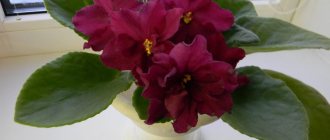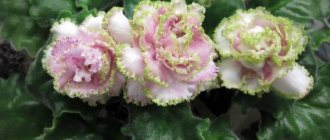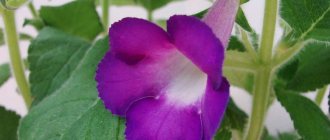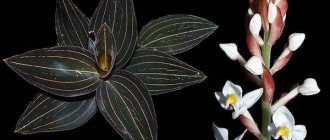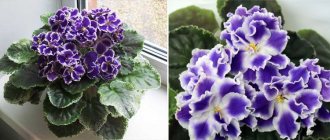Pest protection and disease prevention
Violets are less susceptible to various diseases than other indoor plants.
But if the rules of agricultural technology are violated, various problems arise:
- Spotting. Irregular yellow or brown spots cover the leaves when exposed to direct sunlight or when the leaves are sprayed.
- Chlorosis. It is expressed in yellowing of leaves. Develops with iron deficiency. It is treated by feeding iron sulfate (1 gram per liter of water).
- Gray rot. Fading and wilting of leaves. The only way to save a violet is by trimming and rooting the crown.
- Rust. Brown spots appear on the leaves, then the cuttings become bent. The violet stops growing and does not bloom. The fungus is treated by spraying with copper sulfate or Bordeaux mixture.
- Powdery mildew of violets. The leaves look dusted with flour. The cause of the disease is a combination of cold and high humidity. The disease is treated by spraying with Topaz, Forecast.
Georgia violet may develop chlorosis or rust.
Treatment of diseases is effective only in the early stages. A plant severely affected by the fungus cannot be cured, so it will have to be disposed of so that other plants do not become infected.
Important. If signs of disease appear, it is necessary to carry out an unscheduled violet transplant, regardless of the time of year.
You cannot use an old pot for replanting. The soil and drainage must be replaced. If transplantation is carried out during flowering, all flower stalks must be cut off.
Pests that can enter the apartment from other plants or from flowers cut in a flowerbed cause great harm to violets:
- Aphids are immobile sucking insects that extract juice from leaves and shoots. The surface of the leaves becomes covered with a sticky coating, young shoots become deformed and stop developing.
- Ticks are microscopic insects that are invisible to the naked eye. The leaves of a violet infected with mites begin to become deformed and become covered with white cobwebs and a grayish coating.
- Mealybugs - colonies of pests look like white fluff in the axils of the leaves.
- Sciarides are small mosquitoes whose larvae compact the soil and reduce air access to the roots.
For Georgia violets, not only diseases, but also pests are dangerous.
Names of flowers for creating a balcony flower garden photo
When the first signs of pest infestation are detected, the violet must be isolated from other plants and all damaged parts must be cut off. Then the rosettes with intact leaves need to be transplanted into a new pot with a complete replacement of the soil and drainage layer.
After transplantation, the plant must be sprayed with an insecticide (Alatar, Aktara, Aktellik). To completely destroy the pests, the treatment is repeated three times with a break of 7-10 days.
Diseases and pests
Violets are often the target of mealybugs and red spider mites. If preventive measures in the form of watering from the shower do not help, then it is worth using insecticides to quickly suppress the infestation.
During the summer months, the edges of the leaves may turn yellow or become scorched. The most common cause is exposure to direct sunlight. To get rid of the problem, you will need to close the curtains or move the plant further away from the glass. In fact, foliage on violets can turn yellow for a variety of reasons:
- too much fertilizer, so it’s worth reducing the amount of fertilizing;
- salt formation has begun in clay pots, they should be thoroughly washed and the soil changed;
- insufficient watering.
Water should not be allowed to accumulate in the crown; this leads to the formation of rot, including root rot. Always apply fertilizer to well-moistened soil. If you do this dry, you can easily burn the roots, causing the leaves to droop and rot. Gray or white formations on the foliage, shoots wrinkle and curl, the main cause is powdery mildew. Very high humidity causes the disease.
You can learn more about how to rejuvenate violets below.
Georgia Dadoyan violet photo
Uzambara violet.
Family Gesneriaceae - Gesneriaceae.
Genus Saintpaulia hybrida - Hybrid Saintpaulia.
African violet saintpaulia hybrid.
Violets from breeders of the CIS countries - “D”.
Georgia (T. Dadoyan).
Is it possible to keep dried roses and other dried flowers at home? how to bypass the ban
The flowers are very large, double, bright pink with a crimson-coated border, the edges of which are decorated with a thick, ruffled green ruffle.
Varietal rosette with straight leaves. Foliage grows very little, elongated petioles. The leaves age and turn yellow very quickly. The rosette is large, sloppy, problematic, and twists the leaves.
When blooming, the color is pale pink, but after a couple of days it becomes deep pink, then lightens slightly. The width and saturation of the border, as well as the brightness of the main color, varies depending on age and time of year. In cool conditions the flowers develop a nice greenish ruffle.
Different peduncles of the same rosette can produce flowers of different color intensity. The first flower on the peduncle is the largest - up to 6 cm, the rest are slightly smaller.
From one leaf you get both wavy children and those with straight leaves. It grows very slowly. It is necessary to remove the flower stalks several times in a row, then the leaf mass begins to grow. The socket got better after I switched it to the wick. A sport with curly leaves, a very ugly rosette.
Georgia is a state in the southeastern United States. The capital and largest city is Atlanta. Georgia's official nicknames are the “Peach State” and the “Imperial State of the South.”
Before the Spanish colonization of America, there was an Indian culture in Georgia that completely disappeared by 1560.
Do you know that…?
- Elegant spathiphyllum wallis: is it easy to grow at home and are there any difficulties in care?
Pink varieties. This category includes all shades of pink, from delicate to rich, almost raspberry. Pink is one of the most difficult colors.
There are many shades of pink: hot pink, hot carmine pink, dark pink, light pink, bright peach, mauve, soft pink purple, warm, cool, muted, beige pink and taupe pink. -raspberry and pink-coral. Any pink is always a complex mixture of several tones.
Before you buy the violets listed below, carefully read the forums about their behavior on the windowsill. Many of them are very beautiful flowers.
Are they suitable for your window sill and the conditions that you can create for them? You will look at the flowers for several months, and the rosette will always be in front of your eyes.
There are many beautiful flowers, there are much fewer beautiful and neat rosettes, look first at the rosette! Search and you may find a dozen violets with the same flower color if you are not interested in the smallest details as a collector.
• — Wedding Day (Lazarenko); • — Day by Day (Arkhipov); • — Curiosity (Morev); • — Brownie Kuzya (Burkatsky); • - Dulcinea (Prilutskaya);
Violet, thanks to its beauty and variety of varieties, has won the love of many plant growers. It does not require much attention to itself, but will delight you with large and beautiful flowers if you fertilize it on time and give it the necessary amount of light and moisture.
Description of the variety
Violet "Georgia" from breeder T. Dadoyan has pink, large double flowers. Along the edge they are decorated with a yellow-green border and a crimson coating. The border can be thick or thin, depending on the time of year.
The intensity of the color of the flowers also changes. The first flowers are the largest, they reach a diameter of 6 centimeters, the subsequent ones are smaller. There are many flower stalks, and when the buds bloom, they fall under the weight.
In order for the leaf mass to grow, it is necessary to remove flower stalks more often. There is not a lot of foliage on the bush; it is all straight, quickly dies and loses its attractiveness, and therefore requires timely pruning.
The rosette turns out to be sloppy, so the foliage often curls.
Indoor conditions
In general, violets are able to adapt to different indoor conditions, but sometimes they can be capricious and not bloom.
It is best to maintain the inside temperature between 21 and 23 degrees during the day and at night at least 15 degrees. These are plants that prefer high humidity in their environment.
It is especially important to take care of this in winter, when the heating is on in the room and the air becomes completely dry.
Description of the Georgia violet variety and care for it
Violet, thanks to its beauty and variety of varieties, has won the love of many plant growers. It does not require much attention to itself, but will delight you with large and beautiful flowers if you fertilize it on time and give it the necessary amount of light and moisture.
Growing a flower
Planting English roses is somewhat different from planting other types of plants. To make them feel comfortable, it is recommended to follow certain rules: prepare a high-quality landing site, as well as planting material.
Rose Falstaff - variety description
Any option can be used as planting material: seeds or seedlings. However, a large percentage of seeds may not germinate. It is also worth understanding that the characteristics of the parent plant may not be preserved, and therefore the gardener will receive another bush. With seedlings everything is simpler - they take root better, are more likely to take root, and also do not require any special care.
Note! It is recommended to plant in open ground in the spring, when the ground has warmed up. However, it is worth preparing the soil and the flower itself for planting in advance.
This requires at least 3 months, and therefore it is recommended to take care of this in advance.
Selecting a location
Teasing Georgia rose requires planting in a place where there is a fence or wall nearby. They will help protect the plant from gusty winds, which is especially dangerous in winter, since it can blow away the snow cover that protects the flower from frost.
Important! This variety of rose does not like the sun's rays, and therefore it should be planted in shaded areas where the sun does not reach most of the day, but shines for about 5-6 hours a day
At the same time, you should avoid areas where water may accumulate.
The best place to plant a bush
How to prepare the soil and flower for planting
Before planting, seedlings should be prepared: it is necessary to inspect the roots and remove damaged ones, treat the cut areas with activated charcoal or charcoal to disinfect them. Then you need to place the seedling in a root formation accelerator solution for 12 hours.
Soil preparation should begin in advance:
- Dig a hole about half a meter deep and wide. Do this by transshipment, dividing the top and bottom layers into two parts.
- Mix soil with fertilizers.
- The top layer must be lowered to the bottom of the hole, and the bottom layer must be left for pouring.
This substrate will not only be rich in useful microelements, but also saturated with oxygen, due to which the roots will develop faster.
Step by step landing procedure
First of all, you need to dig a hole with a depth and width of 45-50 cm. You should fill its bottom with a small amount of drainage, which can be small pebbles and coarse sand. You should place the plant on top of the embankment, carefully distributing the roots along the hill, and then sprinkle them with soil, lightly pressing it. After planting, it is necessary to water the plant abundantly.
After planting, abundant watering is required
Reproduction of a miniature plant
The easiest way to propagate a flower is by cuttings. In order to choose the right cutting, you need to find a healthy leaf that has no damage. For the process to be successful, the leaf must be green. Those leaves with less than 30% green surface, as a rule, either die at the very beginning or do not produce good offspring. It is recommended to place the selected leaf for a short period of time in a fungicide solution to protect the cutting from various fungal diseases.
Also, after separation from the mother plant, the cuttings are washed in warm water. Then, using a sterile knife, make a new cut, leaving about a centimeter
It is important that the cut is smooth and clean, so the tool you use to cut the cutting must be well sharpened. The cut area must be disinfected by treating with crushed charcoal
It is recommended to immediately root these miniature flowers into the ground, without first keeping them in a glass of water. This increases the likelihood that the flower will take root. The soil should have good air permeability.
The leaf is lowered into the ground at an angle of 45 degrees. Having lowered the leaf, you need to carefully sprinkle it with the mixture, and then pour it a little with warm, settled water. The depth of the hole should be no more than a centimeter.
A few weeks after planting, when the plant has taken root properly and 3 pairs of leaves appear, you can plant it. They are planted in normal pots and normal soil in which flowers are grown. If the lower leaves begin to deteriorate, you must remove them immediately and add a little more soil. Thanks to this, roots will also form there. It is better to avoid early flowering to preserve the plant's vigor.
Basics of proper care and maintenance
Lyubasha's indoor violets are not capricious and finicky plants, but they require strict adherence to the rules of home care and maintenance. Only with proper cultivation can you get healthy and harmoniously developed flowers.
Growing space and lighting
The ideal location for violets would be a north window. If you plan to place it on the sunny side of the room, then it is safest to place the pot with the plant on a table next to the window or on a wall shelf. In this case, the window glass must be curtained with translucent fabric or paper to protect it from direct sunlight.
Violet requires about 10 hours of daylight daily for healthy growth and development. During the flowering period, they need more light, so it is advisable to install additional lighting sources, such as fluorescent lamps, at this time.
Temperature and humidity
Do not allow the room temperature to drop below 18 degrees.
In the summer season, a comfortable temperature is considered to be between 20 and 25 degrees. In winter, the room temperature should not fall below 16 degrees, but it is better if it is between 18-21 degrees.
The room with violets should be regularly ventilated, but without drafts. The plant should be protected from sudden changes in temperature and should not be taken outside even in warm weather.
For timely flowering indoors, you need to maintain the humidity level. The ideal option is 50-60%. In hot weather, it is recommended to place the pot with the plant on a wide tray with damp moss or peat.
Watering
It is best to moisten violets with warm melt water or filtered water. When using running water, it must be allowed to sit for a couple of days in an open container. The plant requires watering if the soil mixture in the pot has become dry to the level of an earthen lump at the root. As a rule, in winter violets are watered once every 3-4 days; in summer, daily irrigation is acceptable.
Watering violets is carried out using a watering can with a thin spout, carefully and without getting on the leaves. It is permissible to pour warm water into the pan: the plant will take the required amount of moisture, and the rest of the water must be drained to prevent rotting of the root system.
It is not advisable to spray plants, but during the flowering period it is allowed to lightly spray water on the foliage without flooding the inflorescences.
Fertilizers and fertilizers
In order for the soil in the flowerpot to be endlessly nutritious, it must be systematically fertilized. During the period of active growth, violets need nitrogen fertilizers: they help in the formation of new leaves.
In order for the Lyubasha violet to bloom actively and luxuriantly, it needs fertilizing.
The main thing is not to overdo it, because a large amount of nitrogen leads to the cessation of flowering. To form buds, potassium-phosphorus fertilizers are applied.
Indoor violets are fertilized 2-3 times a month, but you should not apply fertilizer immediately after transplantation (1-2 months), in extremely low or high temperatures, in dry soil, and if the plant is weakened by diseases and pests.
Typically, violets growing on windowsills are fed from February to November. Flowers grown on shelves under artificial light - throughout the year. It is better to apply fertilizing through a tray to protect the foliage from possible damage.
Feeding schedule and rules
The nutrients contained in the soil last the violet for exactly two months. Then, to ensure normal development and stimulation, the violet must be fed regularly, alternating organic and mineral fertilizers.
The schedule and composition of fertilizers depends on the stage of development and age of the plant:
- For lush and bright flowering, Georgia violet needs fertilizing.
Young rosettes that are actively growing leaf mass are fed once a week with organic fertilizers. You can use hoods such as Biohumus, Humate.
- Young rosettes that have begun to bloom are fed once every 3 weeks with mineral mixtures. The concentration of the solution for young violets is reduced several times.
- During foliage growth, adult rosettes are fed once 2 months after transplantation with nitrogen-containing fertilizer.
- From the beginning of bud formation and until the end of flowering, adult rosettes are fed once every 2 weeks with mineral fertilizers. The main elements needed by the plant during this period are phosphorus and potassium.
Important. After the first wave of flowering, the plant must be given a rest for 30 days, and then fertilizing with mineral mixtures should be resumed.
Fertilizers for fertilizing are diluted in water 3-4 degrees warmer than room temperature and applied to the soil only after watering. To ensure even distribution of nutrients in the soil, it is recommended to feed violets using the immersion method. The pot with the plant is placed in the fertilizer solution for 30 minutes so that the liquid saturates the soil through the drainage hole.
Diseases, pests and ways to combat them
Preventing the development of diseases can be considered spraying with potassium permanganate, as well as a solution of ash. The rose itself is quite resistant to infection, rust and deformation of leaves, but this does not mean that you can calm down and not take measures to prevent the appearance of insects and diseases.
A description of the external characteristics of a rose cannot tell about its beauty. It is great for decorating a garden plot, and therefore is a favorite of many gardeners. It can be cared for by both a novice florist and a master of the craft.
source
Growing and care
Sea wolf, a variety of violets with giant decorative flowers: review + video
Agrotechnical measures are no different from caring for other varieties. The plant needs to be watered regularly, combining watering with fertilizing. Growing a rose bush involves sanitary pruning. It will have to be constantly inspected for diseases and pests.
Watering and fertilizing the Tizin Georgia variety
Roses of English selection are not demanding of high soil moisture, which needs to be moistened no deeper than 2 cm. The best time for watering is considered to be evening. If the rose is more bushy, less water will be needed to water it (about 1 bucket), and for a climbing rose, more water will be needed, about 15 liters.
It is better to water the rose in the evening
In the first year after planting, the plant is not fertilized; it only needs useful substances embedded in the hole during planting.
In the second year, feeding is strongly recommended:
- The first of them should include nitrogen, necessary for increasing the vegetative mass of stems.
- The second time, nitrogen compounds and phosphorus are used to prepare the nutrient solution. It promotes abundant flowering, making the budding process more intense.
- In anticipation of cold weather, roses are fed with potassium group fertilizers (you can use ash). This category of elements strengthens resistance to low temperatures.
In addition to moisturizing and feeding, you need to organize the formation of the plant. It is pruned in early spring and autumn, before the onset of frost. For preventive purposes, broken and dry shoots are removed.
Pruning roses
Then, by truncation, the stems are formed as desired:
- low rose - for this, the shoot is shortened by half with pruning shears;
- voluminous bush - to give it a more magnificent appearance, cut off one third of the side branches;
- long curly shoots - cut off only a fifth of the stem.
On a note. Since pruning is stressful, at the end of the procedure the bush needs to be fed with complex fertilizer.
Disease Prevention
These activities are part of the entire system of care. Varieties of English roses are considered resistant to infectious diseases and pest attacks. But they can also get sick. Signs of fungus are the appearance of small black spots on the leaf and its deformation. Preventive spraying with potassium permanganate or ash solution will help.
Rust also damages the crop, as evidenced by growths and yellowish spots. Later they darken and remain on the shoots all winter.
Rust on the rose
At the end of the season, after flowering has completed, care should be taken to cover the bush for the winter.
Plant care
Despite its rather unique appearance and different planting method, caring for the plant should be the same as for other varieties of roses. This means that you can relieve yourself of the responsibility for learning other rules that would need to be followed when caring for a flower.
Watering rules and humidity
It is recommended to water in the evening strictly at the root of the bush. Despite the fact that the plant can survive rain without causing the flowers to wither, it is still not worth risking them again. English rose does not require high soil moisture, and therefore it is necessary to water the soil to 2 cm, no more.
For your information! Depending on the degree of bushiness of the rose, it may need different amounts of water for watering. Curly ones need to be watered with 15 liters of water, and for bushy ones one bucket is enough.
A dry climate can cause the bush to dry out, but excessive air humidity will not improve its condition. If the rose's root system is constantly waterlogged, this may contribute to the appearance of rot. However, increased air humidity can promote the development of fungus or an influx of insects.
Fertilizing and soil quality
The soil for growing should be light, oxygenated, and rich in nutrients. For active growth and abundant flowering, constant fertilization is required. In the first year after disembarkation, such activities may not be carried out. Starting from the second year, it is worth applying the following types of fertilizing at certain periods:
- during the growing season, the plant needs nitrogen to form stems;
- during the formation of buds and subsequent abundant flowering, nitrogen and phosphorus fertilizers are required;
- To increase frost resistance, it is worth starting fertilizing with potassium at the end of autumn.
It is not recommended to risk the plant by applying fertilizing in the wrong order, as this will confuse the rose; it may begin to lay buds during the dormant period, or begin to grow greenery abundantly during the budding period.
Pruning and replanting
Plant formation is especially important for the plant. Pruning should be done before the onset of frost in autumn and early spring.
Preventive removal of dry and broken shoots will allow the bush to send out fresh shoots more intensively. You can trim the stems as desired:
- severe pruning - shortening shoots by half their length;
- middle pruning - removing only side shoots;
- light pruning - removing a fifth of the stem.
Important! To complete the formation of the bush, feeding is required so as not to drive the plant into stress. It is also necessary to remove faded buds
Bush after pruning
Features of wintering a flower
Before wintering, it is recommended to remove all fallen leaves from under the bush, and also treat the plant with drugs that prevent the occurrence of fungal infection. Not every winter there is a large amount of snow, and therefore it is worth building additional shelter. It is made from spruce spruce branches, which are covered with lutrasil on top.
The branches need to be bent to the ground. If they are not flexible enough, you can carefully dig them up on the side opposite the fold. To prevent the branches from starting to rot, you should place spruce branches under them and secure them with staples in this position.
Rules of care
Tason responds to good care, but there are no particular difficulties in growing this variety.
Trimming and shaping
Due to their strong growth, grape bushes must be shaped. The simplest way is a fan. You can also form a bush in the form of a two-armed cordon or grow it on an arch. In warm regions where grapes do not need to be covered for the winter, they can be cultivated in standard form, like a tree.
It will take 3–4 years to obtain a fan-shaped bush.
When pruning, you need to remember the basic rules:
- The optimal load for Tason is no more than 30–40 shoots per bush.
- Each vine should be pruned with 10–12 buds.
High-bole grapes can be grown in warm regions
In autumn, the grapes are pruned, removing unripe parts of the vine, excess branches and thickening shoots. If winter temperatures in the region drop below -22...-24 °C, the vines should be laid on the ground and covered at the end of October. Agro-fabric, a layer of soil, straw or oilcloth are suitable.
To protect grapes from frost, it is necessary to tie the vines, lay them on the ground and cover them with straw.
Watering
Grapes need moderate watering - excess moisture will only harm them. Usually watered 3-4 times per season:
- After flowering ends.
- During the ripening period of berries.
- After the harvest.
- Before the onset of cold weather.
To better retain moisture in the soil under the bushes, it is recommended to mulch the tree trunk circle with natural materials:
Latest posts 5 unusual zucchini dishes instead of the boring pancakes and stews 8 folk remedies for fighting the Colorado potato beetle: for those who are against “chemicals” in the garden 5 ways to use garlic arrows, which experienced gardeners know
- peat,
- sawdust,
- mown grass.
Feeding
To get a bountiful harvest, you need to regularly fertilize the vineyard.
- The first root feeding is applied a few days after flowering.
- Then the plants are fed at the beginning of berry ripening - this helps to increase the average weight of the bunches.
- The last fertilizing is carried out in the fall with potassium salts, which increase the frost resistance of plants.
Organic substances are added in the form of slurry or infusion of chicken droppings; rotted manure can also be used (used as a layer of mulch 7–10 cm thick). Do not forget that microelements are very useful for grapes:
- boric acid;
- manganese sulfates;
- zinc sulfates.
Grapes respond well to foliar feeding. To do this, prepare aqueous solutions of fertilizers:
- nitrogen (ammonium nitrate 0.3%);
- phosphorus (superphosphate 5–7%);
- potassium (potassium chloride 1.5%).
Fertilizing can be combined with preventive spraying against fungal diseases.
Indoor conditions
In general, violets are able to adapt to different indoor conditions, but sometimes they can be capricious and not bloom. It is best to maintain the inside temperature between 21 and 23 degrees during the day and at night at least 15 degrees. These are plants that prefer high humidity in their environment.
It is especially important to take care of this in winter, when the heating is on in the room and the air becomes completely dry.
Professionals use automatic humidifiers; you can take a simple spray bottle or place containers with pebbles and water on the window. An east or west window is best for violets. You can also use the northern part, but only in summer.
Watering
When watering violets, the grower should avoid getting water on the leaves, since moisture becomes the main cause of subsequent fungal infections. The main problem that novice florists do not think about is water temperature. If it is cooler or hotter than the foliage, it can cause damage called "ring spot."
The temperature of the irrigation liquid should be from 18 to 23 degrees. This is the threshold that is considered safe for most indoor plants. To preserve a flower, it is better to water it under a bush or use a wick, a container with small stones and water. The long spout of the watering can allows you to properly moisten the soil without splashing the leaves. One of the main problems that the grower faces is the formation of white spots on the leaves. This happens when cold water enters.
We cannot rule out completely moistening the soil from above, since this is how it is possible to remove excess salt from the soil, which is deposited as a result of fertilizing. It is always necessary to check the soil before adding a new portion of moisture. If it is still wet, it is worth postponing the procedure for a few days, otherwise the grower will face the problem of root rot.
Pest protection and disease prevention
Violets are less susceptible to various diseases than other indoor plants.
But if the rules of agricultural technology are violated, various problems arise:
- Spotting. Irregular yellow or brown spots cover the leaves when exposed to direct sunlight or when the leaves are sprayed.
- Chlorosis. It is expressed in yellowing of leaves. Develops with iron deficiency. It is treated by feeding iron sulfate (1 gram per liter of water).
- Gray rot. Fading and wilting of leaves. The only way to save a violet is by trimming and rooting the crown.
- Rust. Brown spots appear on the leaves, then the cuttings become bent. The violet stops growing and does not bloom. The fungus is treated by spraying with copper sulfate or Bordeaux mixture.
- Powdery mildew of violets. The leaves look dusted with flour. The cause of the disease is a combination of cold and high humidity. The disease is treated by spraying with Topaz, Forecast.
Georgia violet may develop chlorosis or rust.
Treatment of diseases is effective only in the early stages. A plant severely affected by the fungus cannot be cured, so it will have to be disposed of so that other plants do not become infected.
Pests that can enter the apartment from other plants or from flowers cut in a flowerbed cause great harm to violets:
- Aphids are immobile sucking insects that extract juice from leaves and shoots. The surface of the leaves becomes covered with a sticky coating, young shoots become deformed and stop developing.
- Ticks are microscopic insects that are invisible to the naked eye. The leaves of a violet infected with mites begin to become deformed and become covered with white cobwebs and a grayish coating.
- Mealybugs - colonies of pests look like white fluff in the axils of the leaves.
- Sciarides are small mosquitoes whose larvae compact the soil and reduce air access to the roots.
For Georgia violets, not only diseases, but also pests are dangerous.
When the first signs of pest infestation are detected, the violet must be isolated from other plants and all damaged parts must be cut off. Then the rosettes with intact leaves need to be transplanted into a new pot with a complete replacement of the soil and drainage layer.
After transplantation, the plant must be sprayed with an insecticide (Alatar, Aktara, Aktellik). To completely destroy the pests, the treatment is repeated three times with a break of 7-10 days.
Violet
Violet "Esmeralda" is in the collection of two breeders - E. Lebetskaya and S. Repkina. Elena Lebetskaya developed the variety “LE-Esmeralda” in 2009. The breeder adds this prefix to all names. Svetlana Repkina’s variety is known as “RS-Esmeralda”.
Dear readers! For you, we have created communities on social networks in which useful articles and interesting ideas are published several times a day! Subscribe and receive useful content in a convenient format!
Description
The name "Esmeralda" is translated from Spanish as "emerald". Many people associate it with the main character of Victor Hugo’s novel “Notre Dame de Paris.” This flower is extremely beautiful and has a slightly capricious character, like the gypsy woman from the work.
Leaves
The leaves of the plant are large and velvety. They are uniformly colored in a pleasant green color. The rosette is a little wavy, but neat and even.
Flowers
- "LE-Esmeralda" has large terry corollas in the shade of ripe raspberries. The flowers are abundant and lush, they look harmonious with an even green rosette.
- "RS-Esmeralda" is distinguished by large double flowers, their volume can reach 7 cm, as in the photo on the left. There is a white edging along the edges of each flower, with a more saturated color in the middle.
Features and differences from other varieties
The flower is distinguished by an unusual green edging; it remains cool in the room.
In other cases, it may slowly turn white. The first flowering is characterized by the formation of many peduncles.
Afterwards the flower opens completely, forming a lush cap. She stays for three months.
Violet is not stable; identical sockets are rare. In winter, the bud opens up to 6 months, but the flower dies. In spring and summer the process goes faster.
Planting and propagation
Before planting, it is important to decide where to place the pot. It is better to place the violet on the windowsill or nearby. It is advisable to leave it on the north side to avoid direct sunlight
The plant is usually grown from a leaf
It is advisable to leave it on the north side to avoid direct sunlight. The plant is usually grown from a leaf.
Reproduction usually occurs by stepson, leaf, peduncle and cuttings.
The easiest way is leaf propagation. This process is best started in the spring or summer. It is better to take a leaf from the second or third row; it should be bright green, hold its shape well and be free of damage and stains.
If you root using water, you need to dissolve activated carbon in a disposable glass. After immersing the leaf by 1 cm, place it in a warm place (not in the sun) and after the roots appear about 1 cm, plant it in the soil.
Fertilizer and feeding
At the beginning of spring, violets need to be fed with nitrogen fertilizer. When buds form, you need to add phosphorus and potassium fertilizers. You need to do this once every 14 days. You need to buy fertilizers at a flower shop and follow the instructions. In winter, fertilizing is not needed.
Diseases and pests
The most famous ailments of the plant:
- Powdery mildew. It is expressed in the formation of a white coating on the leaf. The disease develops due to excessive humidity and low temperature. To cure the plant, the drugs “Topaz” and “Saprol” are used. Dusting with sulfur powder also helps;
- Rust occurs due to water getting on the leaves;
- Gray rot is a fluffy coating with a gray-brown tint. It appears with improper care and can destroy the plant.
Find out more about caring for violets in the video below:
Violet "Esmeralda" constantly participates in exhibitions and is in great demand. The flower growers forum almost unanimously recognizes the flower as the most beautiful, but very delicate.
Description of the variety
Violet "Georgia" from breeder T. Dadoyan has pink, large double flowers. Along the edge they are decorated with a yellow-green border and a crimson coating. The border can be thick or thin, depending on the time of year.
The intensity of the color of the flowers also changes. The first flowers are the largest, they reach a diameter of 6 centimeters, the subsequent ones are smaller. There are many flower stalks, and when the buds bloom, they fall under the weight. In order for the leaf mass to grow, it is necessary to remove flower stalks more often. There is not a lot of foliage on the bush; it is all straight, quickly dies and loses its attractiveness, and therefore requires timely pruning. The rosette turns out to be sloppy, so the foliage often curls.
Reviews from flower growers
Flower growers note that the Georgia violet has very beautiful flowers.
Irina . Flowers of the Georgia variety are simply gorgeous, not violet. For such beauty of flowers, one can forgive the variety even a spreading rosette with twisted foliage. Although the rosette looks sloppy only in young rosettes, as the violet grows older it evens out.
Elena . To grow the rosette, it took about two months to remove the flower stalks. But the leaves still grow very slowly. But the variety is very colorful. To get a green ruffle, you need to keep the plant at a temperature no higher than 21-22 degrees.
Svetlana . My relationship with the variety did not work out from the very beginning. I was jealous of my friend’s gorgeous Georgia flower and took two leaves. At first I waited six months for the children, then the rosette grew and became like a helicopter with five blades. Flowers appeared only after 2 years, and even then they were not as gorgeous as my friend’s. In general, I eliminated Georgia and decided not to suffer anymore.
Reproduction methods
There are 4 methods of cultivating violets, thanks to which you can replenish your plant collections:
Leaf (or cuttings): a healthy leaf is cut at an angle of 45 degrees, no more than 4 cm long, washed with warm water. Root in both light soil and water. Effectiveness increases if you add crushed sphagnum moss and peat tablets with humus. A month later, the babies will appear, they are separated and transplanted. When rooting in soil, make a greenhouse with a glass jar or polyethylene, remove it after a little more than half a month.
Stepchildren: a stepson (daughter rosette) is a small process that appears in the axil of a violet leaf; it is advisable to remove them. Before separating the stepson from the plant, pinch its growth point and wait until 4-5 leaves appear. Then the stepson is carefully cut out and rooted in a pot, covered with film. When several stepsons appear, one is left and the rest are removed.
Children: a child is a small independent sprout with its own root. Children of the Uzambara violet germinate at the rooting site of the cutting in 2.5-3 weeks. There can be several of them at once if there was a strong cutting. Next, you need to wait for 2-3 pairs of leaves, after which the children are separated and planted. They are separated in two ways
One of the methods is best done by hand, carefully remove it from the pot, clean it from the soil, then separate the children from the cuttings and from each other. The second is “closed”, the children are separated as the root grows and is formed by cutting with a sharp knife and transplanted into a container with a substrate for violets
This method is effective because the mother cuttings are not injured, which makes it possible to obtain several more groups of children.
By seeds: seeds can be collected or purchased. To sow Uzambara violet seeds, including the Margaret variety, you need a container no deeper than 5 cm; it is filled with loose substrate into a ball 1-1.5 cm smaller than the depth of the container. Sow violet seeds in moistened soil evenly over the surface and cover with glass or white paper to create a stable temperature. The temperature regime is maintained in the range from 17⁰C at night to 21⁰C during the day. We must not forget about periodic ventilation; in the first days it is carried out very carefully. After 15-20 days, the first shoots will appear; as they grow after picking and growing, using the same greenhouse method, the shoots are planted separately.
Features of growing from seeds at home
How is horned perennial violet grown from seeds? Propagation of viola by seeds provides the plant with greater resistance to diseases.
Sowing seedlings
Violet seeds are sown for seedlings in February:
- A layer of drainage made of expanded clay or other materials is laid on the bottom of the container, then the prepared earthen mixture;
- The substrate is disinfected with a freshly prepared hot solution of potassium permanganate (0.5 g dissolved in a liter of water) and dried in air;
- Make grooves at intervals of 1.5-2 cm and a depth of 0.3–0.4 cm, lay out the seeds, cover them with earth and water and moisten them by spraying;
- Greenhouse conditions are created, the film is opened slightly once a day for ventilation.
Important! After germination, the seedlings are placed in good light at an air temperature of up to 18 °C.
What do the shoots look like?
The sprouts that appear have two rounded leaves on a thin stem. For 2 - 3 weeks they should be shaded from bright sunlight.
Picking
After the formation of several pairs of true leaves, a pick is carried out - transplantation to a permanent place.
There should be some distance between the violets when planting.
It is recommended to do this already in April, since the seedlings can withstand frost. The interval between violets is 5 cm.
Features of sowing in open ground
Sowing of seed material is carried out in the period August 10-September 10:
- The earth is loosened and grooves are formed;
- The seeds are covered with soil, watered, and mulched.
Seedlings will appear only next spring. If the crop is too thick, pick it. You can start replanting them in August.
Seed germination
The packet of seeds indicates the similarity, which can range from 60 to 95%. This should be taken into account when sowing. In open ground, sprouts need traditional care.
The most popular varieties
Dadoyan worked with violets for about 5 years and during this time there are no more than 20 varieties of her selection. The most commonly heard varieties are:
- Georgia - violet flowers are large, double, bright pink in color with a crimson border-spray, the edges of the border are decorated with a thick, corrugated green ruffle. Strong peduncles, curly basal rosette. The leaves are regular, slightly pubescent. Georgia contains a lot of buds on the bush, the flowering period is short.
- Maria is a beautiful curly sport from the Fairy variety. It has large, heavily double pink flowers with a raspberry coating and a green ruffle along the pom-pom flower.
- Aquatic - flowers are bright deep blue, double, with streaks or lightened fragments along the edges of the petals of a pinkish tint. Along the edge of the petals there is a green ruffled border. The leaves are dark, quilted with a slightly wavy edge. Sometimes the leaves have red spots on the white backside. The violet grows quickly, the buds blooming very slowly, but simultaneously.
- Snow White - the flowers of the plant are large, in the form of fluffy terry balls of pure white color with wavy edges of the petals. The leaves of the violet are glossy, wavy, bright green. The plant stands out for its abundant bouquet flowering.
- Grinya - flowers are large, fluffy, semi-double and double, white with a thick corrugated green ruffle along the edge of the petals. The leaves are regular, lanceolate, slightly pubescent. It blooms with a magnificent bouquet, abundant flowering.
- Droplet is a plant with large, semi-double, white flowers with wavy edges of the petals. Each flower has a distinct purple eye in the center of the bud. The leaves are elongated, light green in color. The rosette is neat at the root. The plant blooms quickly, blooms profusely and for a long time.
- Wild cherry - the flowers of the plant are large, semi-double, bright cherry color with a clear, wide white border. Externally, the flower can be compared to a multi-pointed three-dimensional star. The leaves are dark green, spoon-shaped, lanceolate. Wild cherry is a sport from the Frosty Cherry variety.
- Running on the waves - the flowers are huge, double, variable white with dark blue fragments interspersed. The leaves are regular, dark green. The rosette is neat at the root. The plant blooms quickly, blooms profusely and for a long time.
- The poet Yuri Gal is a soft pink, “porcelain” violet; it got its name in honor of the poet Gal, whose prisoner Tatyana’s father once saved in Stalin’s camps. Then Dadoyan had one goal - to save, survive and joy will come. This plant is capricious; if not properly cared for, it quickly dies, but its goal is also to survive and give joy.
Violet, description and photo Willodene (M.Lineberg/I.Lineberg)
Saintpaulia varieties of foreign breeders “W”.
. (Willow Valley).
Large, simple peachy-pink stars with richer petal tips and a slightly greenish edge.
Large, very wavy dark green leaves with white and pink variegation. The leaves are very wavy and twisted. Large standard. The diameter of the outlet is 40-45 cm, it takes up a lot of space. The rosette of this variety is very beautiful and elegant, it is very decorated with leaves, it is always beautiful, even when it is not blooming. The variegation of the variety is bright, it is different for each rosette.
Simple light peachy-pink two-tone stars with a richer eye and a slightly greenish border. When kept cool, pale pink flowers develop a greenish border.
The flowers are simple, soft pink, the flower itself is nothing special. Flowers against the background of a rosette lose. On one peduncle there can be flowers of varying degrees of terry. The first flowers are up to 6 cm in diameter, then they begin to become smaller.
He is greedy for flowers, he never wears a hat. It blooms once a year, mainly growing leaves and shoots. Only adult rosettes delight with abundant flowering. At the age of 4 years, the rosette can produce a larger number of flowers.
The flowers fade quickly, which is why it is difficult to get a cap; while the next buds are opening, the first ones have already faded, which is why the cap is obtained only in cool conditions.
Easily propagated. The variety that is best grown from the leaf must be chosen; the variegation of leaves is different for all children and the clumsiness is also different. It grows strongly, grows more and more new ones, this is the specificity of the variety. In cool weather there is a lot of white on the leaves.
It does not like sudden changes in temperature, then its leaves begin to curl. Loves natural light on the windowsill, but at the same time hugs the pot. In the center of the shelf, directly under the lamps, the petioles do not stretch out much.
Do you know that…?
In most cases, chemical insect repellents combine well with chemical treatments for diseases. The exception is Bordeaux mixture, and all copper-containing preparations, which are best used separately. Recently, mixtures of pesticides with growth regulators have been used. Mixtures with the disease resistance inducer Zircon are successfully used. The bioregulator improves the penetration of the drug to the “target” and prolongs the period of its protective effect. The use of zircon in a mixture with pesticides allows, without reducing the protective effect, to reduce the pesticide consumption rate by 30-50%, and, consequently, the harmfulness of the treatment. It also acts as a stabilizer for easily oxidized mixture components.
Before you buy the violets listed below, carefully read the forums about their behavior on the windowsill. Many of them are very beautiful flowers. However, these can be large rosettes with large and fragile leaves, with leaves rising up or hugging the pot, forming many stepsons that interfere with the formation of a neat rosette, pulling the stem up and growing into a Christmas tree, bending the trunk, rare flowering with long breaks, fallen flowers or they last little and quickly wither, very long and recumbent peduncles, the color of the flower fades quickly, they do not like bright lighting on the windowsill, they are afraid of the slightest drying out or waterlogging, a large percentage of them go into sports or darken the flower.
Are they suitable for your window sill and the conditions that you can create for them? You will look at the flowers for several months, and the rosette will always be in front of your eyes. There are many beautiful flowers, there are much fewer beautiful and neat rosettes, look first at the rosette! Search and you may find a dozen violets with the same flower color if you are not interested in the smallest details as a collector.
• — Wedgewood Wasp (Wagman); • — Wendy's Maverick (DeLorme-Knapp); • — White Madonna (Eyerdom); • — Wrangler's Gaudy Lady (Smith); • — Wrangler's Green Pastures (Smith); • — Wrangler's Jealous Heart (Smith); • — Wunnerful (Adams);
Classification
All varieties of double violets can be divided into groups according to several criteria. For example, depending on the degree of terryness, two main groups are distinguished:
- Terry;
- Semi-double.
In the photo you can see a terry violet. Also, there is a division into groups, depending on the appearance of the Saintpaulia inflorescence:
- Pectinate;
- Carnation.
According to color scheme they are distinguished:
- Light terry violets;
- Dark terry varieties.
IMPORTANT! Violets of several colors conditionally form separate groups of double Gesnerievs. The first includes Saintpaulias of red, pink and raspberry varieties
The second is formed by plants with blue, blue and lilac flowering.
Among the light representatives of terry, in particular, the following varieties are distinguished:
- Atlantis;
- Bridal bouquet;
- Lyubasha;
- And also several others.
Dark Saintpaulias are adequately represented by the varieties Chateau Brion and Gift for a Beloved.
Most often, on the windowsills of avid flower growers, you can see Saintpaulias with a simple type of terry. These plants differ from all other types:
- Leaf shape (round soft leaves of dark green color);
- And also the structure of the flower of the plant.
In representatives of the genus with a simple type of terry, the corolla consists of 4-6 petals.
Flowers with the so-called comb degree of doubleness usually have at least 6 petals in the corolla of the flower. More often, the number of petals of such a plant can be at least 8-9 pieces.
One of the most famous scallops is the Gift for a Beloved variety. It is also distinguished from other terry varieties by the shape of its petals. The fact is that in plants with this type of terry, the top of the flower has a wavy shape with a fringe on top of the flower.
Semi-double flowers are recognizable:
- By the shape and color of the leaves (round or oval, velvety, light green);
- And also by the number of petals in a flowering rosette (from 6 to 9).
In turn, terry Saintpaulias have 10 or more petals in a flower rosette.
As for the degree of terryness like carnations, such varieties have an incompletely opened rosette with semi-double petals.
ATTENTION! The shape of the flowers of such violets resembles carnation flowers, hence their name.
Description, photographs and features of the variety
Dolce Vita violets are another development of the domestic breeder Elena Korshunova, who introduced this magnificent variety to the world in 2005. The Italian phraseology “Dolce vita” means “sweet life” or “not life, but raspberries,” as evidenced by the rich coral-pink palette of flowers. Today, two sports are officially registered from Dolce Vita - Love and Pigeons.
According to the description, these violets have a neat emerald rosette and double wavy coral-pink flowers with a wide crimson-purple edging along the border of the petals, which can be seen in the photo. The flowers reach 6 cm in diameter and are shaped like stars. They do not have a pronounced aroma.
According to the description, the variety has several characteristic features:
- the rosette has a standard size and does not grow from flowering to flowering;
- fairly strong flower stalks can support 4-5 large flowers;
- all the beauty of these violets begins to appear some time after blooming: at first the flowers are pale in color and have small petals and large stamens, over time they begin to increase in size and gain brightness;
- the plant blooms for a long time, the remaining flowers have time to grow and catch up;
- When grown in acidic soil, the color becomes more intense.
Terry violet: photo and description
Terry violets are a type of Saintpaulia, or, as it is also called, Uzambara violet. A special feature of the species are the flowers, which are soft to the touch and look like velvet.
Such plants, in turn, have their own classification. Among them there are two types:
- Terry;
- Semi-double.
In addition to the soft velvet petals, terry Saintpaulias are easily recognizable among others. They are distinguished from the general mass by the shape and volume of the inflorescences, as well as the shape of the leaf blade.
ATTENTION! The inflorescences of double violets can consist of 10 or more petals, while semi-double ones have from 6 to 9. If the inflorescence consists of less than six petals, then most likely it is a classic violet with smooth petals.
Fertilizers
If the violet is grown under artificial light, then it is worth applying fertilizer year-round in a smaller dose than indicated on the package, but once every 2 weeks. It is advisable to use formulations with a high content of phosphorus and nitrogen, since they are essential for flowering. We must not forget about other microelements and vitamins.
The best choice is a ready-made balanced liquid composition with detailed instructions for use.
Tips for growing Margaret violets from experienced gardeners
If you need to leave, use the wick type of watering of violets. To do this, it is better to use a cord with a diameter of about 3 mm (natural ones are not suitable due to their tendency to rot and strong absorption of excess moisture). For watering, the cord is pulled through the hole at the bottom of the pot, laid out in rings, and the other end is lowered into water.
The length of the second end should be such that it reaches and lies on the bottom of the container with water. When watering through a wick, the water should be cooled, boiled with the addition of activated carbon.
Here are some more tips from experienced gardeners:
When choosing a place for violets in the summer on western windows, be careful: the afternoon sun is quite aggressive and can harm the plant. If you have chosen artificial lighting, then you should first choose a lamp, and then make a shelf for it - they should be the same length. If the distance from the plant pot to the lamp is more than 40 cm, two 40-watt lamps are needed. At 20-30 cm, one is enough. High-moor peat with sand or perlite (2:1) is the best soil
You need to be extremely careful with perlite: it is very dusty and can harm the bronchi and lungs. If salts appear on the surface of the soil in a pot or mold appears, try carefully loosening the top layer of soil, sprinkle with river sand or put fresh sphagnum moss (1 cm).
If you are away for a long time, you can use wick watering of Margaret's violet.
Reproduction
It is believed that violets can be propagated by leaves. This is true, but only partly. If you take the lower leaves, then, indeed, you can root them and get new plants. But in this case, the new plants may not inherit any characteristics of the mother plant. To avoid this, it is recommended to take not leaves, but rosettes or peduncles.
To root cuttings, they are placed in vessels with settled (or filtered) water. Only after 1.5-2 months can you notice young roots at the ends of the cuttings. Sometimes this period extends to 4 months. You can not root the leaves in water, but immediately plant them in a pot - this way the roots will be even stronger. For such seedlings, take pots with a diameter of 5-6 cm. The final transplantation will take place only in 3-4 months.
Soil and container
On the market today it is not a problem to find a special, ready-made soil for violets, but you can make it yourself. The potting mixture is prepared from equal parts of peat, vermiculite and perlite. When replanting, do not compact the soil too tightly, since violets prefer well-aerated soil and bloom in a larger pot, but ensure that the distance between the root system and the walls is no more than 2 centimeters.
The pH of the soil should be about 6.0-7.5; lime can be added if necessary to reduce the acidity of the soil. It is possible to add an infusion of cow manure, but very diluted, as well as loam or clay. It is allowed to use not only clay containers, but also plastic containers.
Transplanting Georgia violets
Violets are replanted annually in late winter or early spring to renew the soil and control the condition of the root system. A plant under the age of 3 years is transplanted together with a lump of earth into a pot of larger diameter. Adult rosettes are transplanted into a pot of the same size (no more than 12-13 centimeters) with a complete replacement of the soil.
[adsp-pro-5]
For replanting, use a loose, light substrate consisting of leaf soil, peat and sand (5:3:1). For looseness, vermiculite (about 10% of the total volume) and a small amount of wood ash are added to the mixture.
Location, lighting and humidity
All flowers require good conditions for their cultivation. Violets of any variety need a well-lit place. However, we should not forget that flowers, including the “Margaret” variety, can die from direct sunlight and the burns they leave on the leaves.
If you have a lot of violets, it is better to equip them with special racks with artificial lighting. Flowers of this species need 12 hours of full light to produce the hormones it needs.
The best place to place them is windows that face east and west. South-facing windows should be shaded with parchment paper or mosquito netting to create diffused light.
In winter, it is better to remove violets away from heating systems and additionally humidify the air, as it becomes dry, which can destroy these plants. 60–70% humidity is recommended for them.
Margaret's violet should not be placed on southern windows - direct sunlight will leave severe burns on the plant.
Temperature
Drafts are contraindicated for the plant; if they are overcooled, their leaves will curl; if they are overheated, on the contrary, rotting may begin. The most suitable temperature for this species is 17-20⁰ C.
At an acceptable cool temperature and good humidity, the characteristics of the “Margaret” variety appear - the color becomes rich and bright, the rosettes develop densely.
Organization of watering
Many people make the mistake of believing that violets prefer constant moisture. In fact, they can be watered only after the top layer of soil has dried, that is, as needed. You should not spray them - water on the leaves under the influence of the sun causes burns on these plants.
The pot should not be allowed to dry out or become flooded; this can cause a number of diseases in the plants. You need to water with lukewarm melted or settled water and preferably through a tray. A description and photo of the process will help you avoid a number of problems associated with watering.
